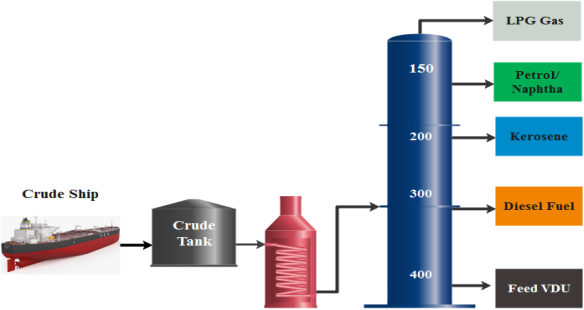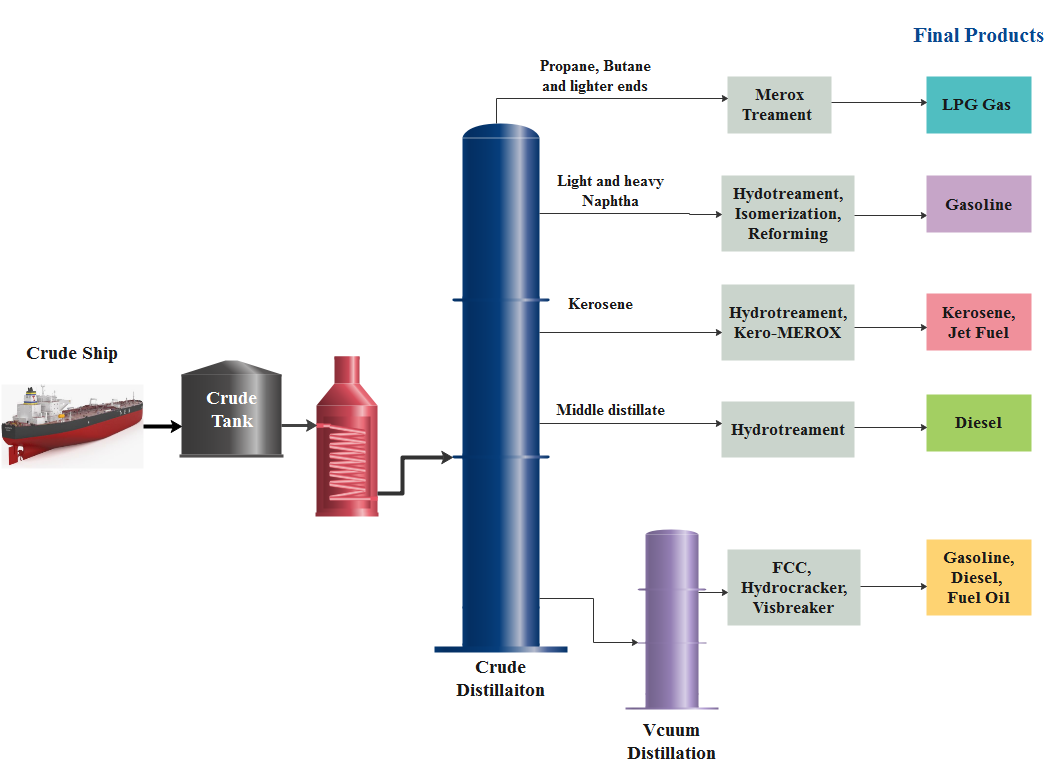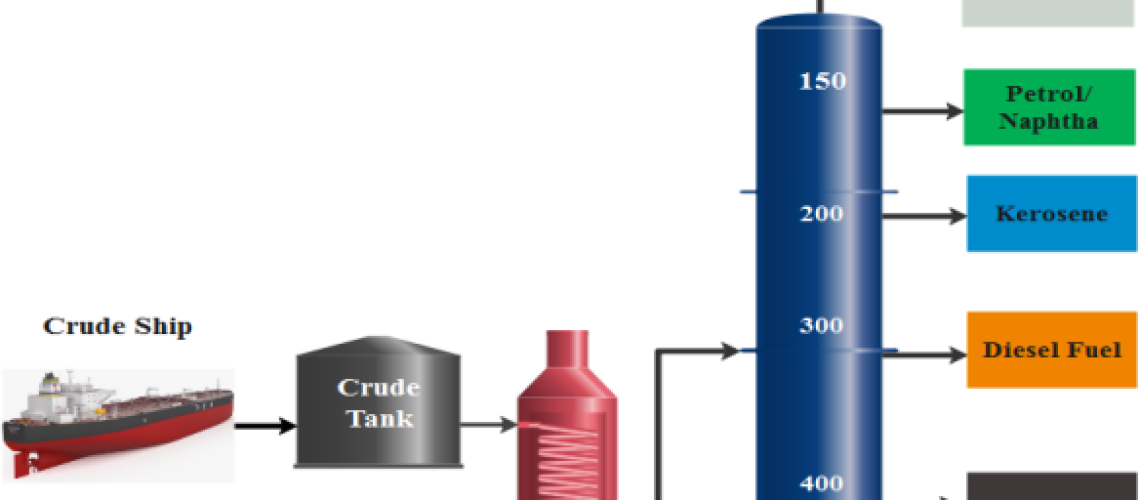A crude oil refinery is a processing facility that transforms crude oil into useful products like LPG, gasoline, kerosene, jet fuel, diesel, asphalt and fuel oil, etc. In addition, it provides feedstock for petrochemical plants. The basics of all refineries are the same, but the specific operations vary and depend on the properties of crude oil and the desired finished products. The oil refining process comprises many steps to achieve the desired products and their quality.
Crude oil is the feed of an oil refinery which is a complex mixture of hydrocarbons. Various types of crude oil exist in the world and each refinery is designed for a specific type of crude. Further details about crude oil can be found in my previous blogs;
Basic Steps of the Crude Oil Refining Process
- The separation of crude oil into various fractions is called fractional distillation. This step is performed in a crude distillation unit, another step for further separation is vacuum distillation.
- Conversion of heavier and lighter fractions of crude oil into more valuable petroleum products. Conversion involves thermal cracking and catalytic cracking, alkylation, reforming, and isomerization processes.
- Treatment of some products to meet the product specifications and also to produce the required feed of the downstream units. Hydrotreating for Diesel, Kero, and Naphtha. For LPG and Kero MEROX processes are also applied to remove Sulfur compounds.
- Blending, storage, and shipping of the finished petroleum products.

Step 1. Separation or Fractional Distillation of Crude Oil
This is the first basic step in an oil refinery and all the refineries use continuous fractional distillation as a primary method of separation of crude oil into components. Crude oil is separated into different fractions in a crude distillation column according to their boiling points. Crude oil is first preheated, desalted (Salts removal), heated in a furnace, and then introduced into a crude distillation column where at atmospheric pressure and temperature up to 400 degrees C, crude oil is decomposed into different fractions. Please view my other blogs related to crude column operation, Working of Crude Distillation Column, and Troubleshooting of crude oil Distillation Column.
These separated fractions become the feedstock of several downstream units to produce the required quality and quantity of petroleum products. Products of the crude column are collected from the top, bottom, and side of the tower. Lighter products, such as butane, LPG (Liquefied Petroleum Gas), and naphtha are recovered at the lowest temperatures from the top of the tower. Mid-range products including kerosene and diesel fuel are collected from the tower side.
The bottom stream of a crude column called a residue or reduced crude is the heaviest stream and is further processed in the vacuum distillation unit to separate into fractions under vacuum. The vacuum helps to boil the heavy feed at low-temperature conditions. The product received from VDU is light vacuum gas oil, heavy vacuum gas oil, and vacuum residuum gas oil.

Step 2. Conversion Processes
Separated products from the crude and vacuum columns are further processed to convert them into more valuable petroleum products. Conversion processes change the size and or structure of hydrocarbon molecules. The most widely used conversion processes are;
a. Thermal Cracking uses heat to convert large hydrocarbon oils into lighter more valuable products.
- The Visbreaker unit thermally breaks heavy residual oils from the vacuum distillation unit into lighter, more valuable reduced viscosity products.
b) Catalytic Cracking uses catalysts for breaking large molecules.
- Fluid Catalytic Cracking Process upgrades lower-value, heavier, and higher-boiling fractions from the crude oil distillation in the presence of a catalyst mainly Zeolite. FCC is mainly applied to gasoline production.
- The Hydrocracker unit uses hydrogen to upgrade heavier fractions from the crude oil and the vacuum distillation units. Hydrocracker is mainly utilized for the production of diesel specification fuel. Other products also include Kerosene and fuel oil.
c) Unification through alkylation and polymerization.
- Alkylation, isobutane reacts with C3~C5 Olefins to produce high octane alkylate which is a mixture of C7~C9 isoparaffins. It is a high-quality gasoline blend. The alkylation reaction is catalyzed in the presence of Sulfuric acid or Hydroflouric acid.
- The polymerization process converts the olefins (Propylene and Butylene) which are in a gaseous state, into larger molecules of gasoline range.
d) Alteration (rearranging) with isomerization and catalytic reforming.
- Isomerization Process, Normal paraffins (Butanes, Pentanes, hexanes) Isomerization process rearranges normal paraffins (Pentanes-Hexanes) into iso-paraffins and straight-chain olefins into iso-olefins which have high octane rating as compare to their parent molecules, in the presence of a catalyst.
- Catalytic Reforming converts the desulfurized low-octane heavy naphtha molecules (C6~C10) into high-octane gasoline called reformate in the presence of a platinum catalyst. This reformate is utilized in gasoline blending. Another major application for catalytic reforming is aromatics ( Benzene, Toluene, and Xylene) production for petrochemical and polymer plants. In addition, reforming is a major source of hydrogen gas, that is utilized in hydrotreating units of the refinery.
Step 3. Treatment Processes
Treatments are applied to remove impurities from the raw products to achieve the desired specification product. Major treatment processes are as follows;
- Hydrotreatment Process is now very critical to meet the product specifications according to the environmental regulations. In this process, the unfinished product is contacted with Hydrogen at high temperature and pressure in the presence of catalysts. This process removes Sulfur, Nitrogen, Oxygen, and metal compounds from Naptha, Diesel, and Kerosene.
- Merox (Mercaptan Oxidizer), removes Sulfur from LPG, kerosene, or jet fuel by oxidizing undesired mercaptans to organic disulfides.
Step 4. Blending and Storage of Petroleum Products
Different intermediate products and some additives are mixed to produce the product of the required specification. Laboratory testing plays a key role to ensure proper blending and product specifications. The finished products are stored in a safe environment of large storage tanks before shipping to customers. For more about blending, view my blog “Blending of Petroleum Products.”
- The gasoline blend is produced by straight-run hydrotreated naphtha, isomerate, reformate, Akylate, FCC Naptha. Octane booster chemicals may be added to get the desired octane number.
- Diesel oil blend is produced by straight-run diesel, Hydrotreated diesel, and diesel from Hydrocracking Unit. In addition, lubricity chemicals to achieve the desired lubricity property or anti-freeze chemicals may be added to the diesel oil blend.
- Furnace oil blend is produced by mixing vacuum bottom, hydrocracking unit fractionator bottom, visbroken bottom, heavy vacuum or light vacuum gas oils.
For further suggestions, discussion and comments please contact at admin@thepetrosolution.com






26 thoughts on “Petroleum Refinery Process”
Some processes are missing, this is not the complete range of refinery processes. Please also write in detail about individual refinery processes and units.
Any idea about visbreaking unit???
Excellent.
I don’t have refinery background but by reading this article basic concepts is clear.
Please refer to unit manuals for detail studies